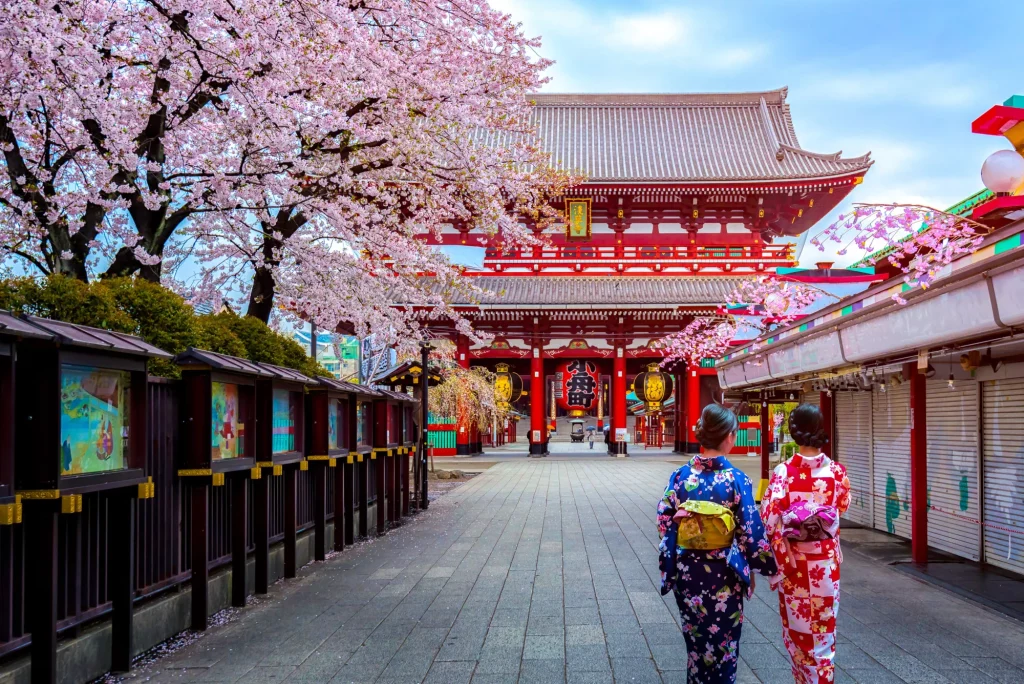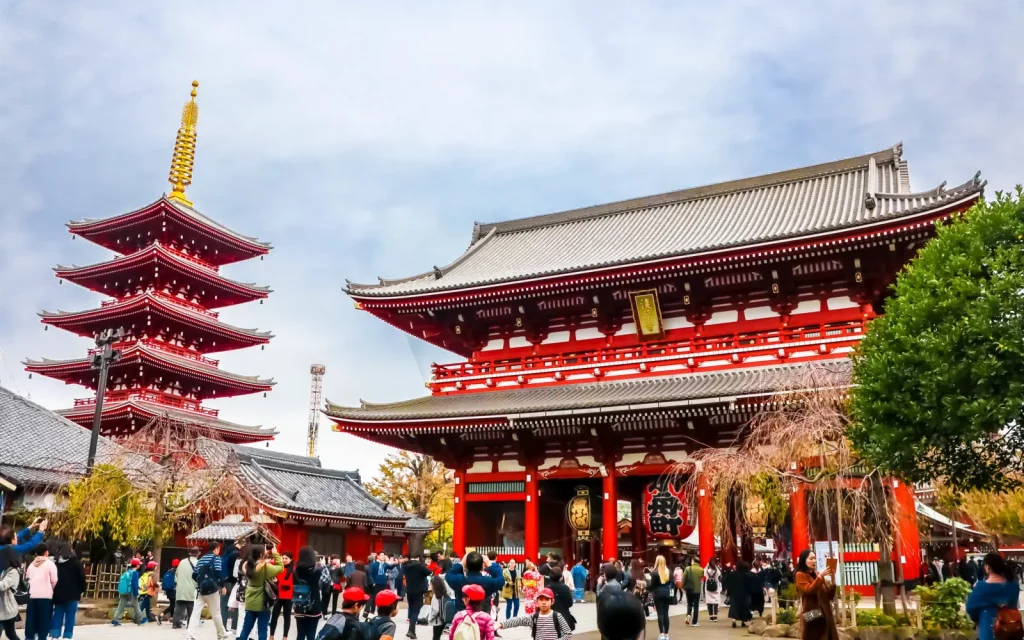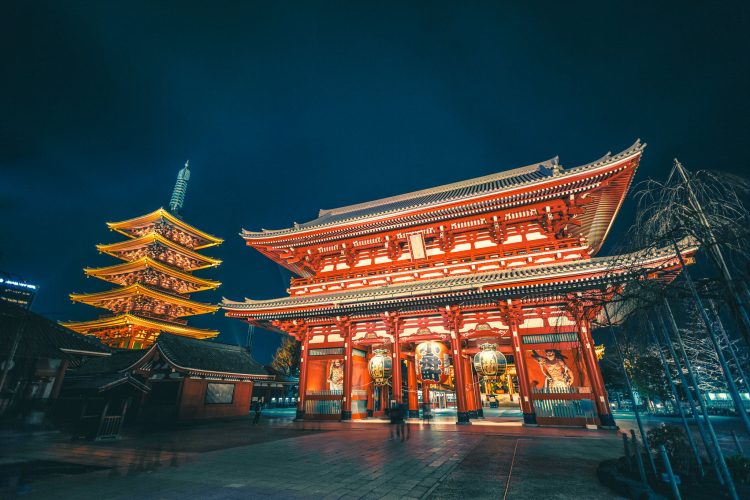In the bustling city of Tokyo, there is a quiet and solemn shrine hidden – Sensoji Temple. This temple is not only one of the oldest temples in Japan, but also an important representative of Tokyo culture, carrying the history and memory of the city. Today, let’s walk into the world of Sensoji Temple and feel its unique charm.
Sensoji Temple: A witness to history
The history of Sensoji Temple can be traced back to 628 AD, when a pair of fishing brothers accidentally found a statue of Guanyin in the Sumida River, and they were convinced that it was the presence of Guanyin Bodhisattva, so they decided to build a temple here to worship the Bodhisattva. This temple became Sensoji Temple, hence its name. After thousands of years of baptism, Sensoji Temple has become an important religious site in the Tokyo area, witnessing the historical changes of the city.
Sensoji Temple is located in the Tai-dong District of Tokyo, located in the bustling downtown area, surrounded by convenient transportation and complete commercial facilities. Coming out of the subway station and walking along the bustling streets, you can see the iconic red gate – Thunder Gate in the distance. The building, which is more than ten meters high, hangs a huge red lantern above, and the four characters of “Wind Thor gate” appear solemn and dignified.

Sensoji Temple: a gem of architecture
Sensoji Temple has a unique architectural style, full of Edo period charm. The main buildings in the temple include the main hall, the third hall, the fifth hall and the 13th hall, each of which embodies the essence of traditional Japanese architecture. These buildings are made of wooden structures and the roofs are covered with heavy straw, giving a sense of simplicity and solemnness.
The main hall is the core building of Sensoji Temple and is dedicated to the Bodhisattva Guanyin. Entering the main hall, the first thing you see is the solemn Guanyin statue. With a kind face and a clean bottle in her hand, Guanyin Bodhisattva seems to be imparting compassion and wisdom to the world. Around the main hall, there are also many small halls and shrines, dedicated to various gods and statues of Buddha. These shrines are beautifully carved, brightly colored and full of art.
In addition to the building itself, Sensoji Temple has many famous attractions. The most famous of these is Raymond. The red gate, which is more than 10 meters high, is the symbol of Sensoji Temple. Huge red lanterns and wind chimes hang from the gate. When the breeze blows, the wind chimes make a pleasant sound, as if telling the long history of Sensoji Temple. On both sides of the thunder gate, there are two tall gods, representing the wind god and the thunder God, guarding the peace of the temple.
In addition, Sensoji Temple has a five-fold pagoda. The tower is tens of meters high and is the only remaining five-fold tower in Tokyo. The tower is a deep red color that complements the surrounding buildings. Around the tower, there is also a peaceful courtyard where visitors can rest and meditate. Here, you can feel a sense of seclusion and serenity, as if time has slowed down at this moment.
Sensoji Temple: a place where cultures meet
Sensoji Temple is not only one of the important cultural heritages of Tokyo, but also one of the representatives of Japanese culture. Here, you can appreciate many exquisite architecture and sculpture works, and feel the unique charm of traditional Japanese culture. At the same time, Sensoji Temple is also closely linked to Tokyo’s folk culture and festivals, becoming an important part of the local culture.
Every year during New Year’s Day and Spring Festival, Sensoji Temple will hold a grand temple fair. These temple fair activities not only attracted countless tourists to come to participate, but also became an important place for local residents to celebrate the festival. At the temple fair, you can taste a variety of food, buy a variety of handicrafts and souvenirs, and enjoy traditional Japanese dance and music performances. These activities not only enrich the cultural life of Tokyo, but also promote the development of the local economy.
Sensoji Temple is also integrated with the local history and culture, becoming an important part of Tokyo culture. Around Sensoji Temple, there are many old neighborhoods and traditional houses, which are full of strong Tokyo atmosphere. Visitors can feel the history and culture of Tokyo, taste authentic Tokyo food and buy unique souvenirs here.

Sensoji Temple: A spiritual baptism
Visiting Sensoji Temple is not only a visual feast, but also a spiritual baptism. Here, you can feel a quiet and solemn atmosphere, as if you are in an isolated holy place. You can pray here, meditate, think about life, and feel the depth of history and culture here.
Entering Sensoji Temple, you will be infected by the solemn and mysterious atmosphere. You can see the devout believers praying, offering incense and spinning prayer tubes in the temple, and you can also see the tourists taking photos, tasting food and buying souvenirs in the temple. Here, you can feel a harmonious and inclusive atmosphere, as if all the people are working for the same goal – the pursuit of inner peace and tranquility.
Conclusion: The charm of Sensoji Temple is infinite
Sensoji Temple is a temple full of history and culture, it is not only one of the important cultural heritage of Tokyo, but also one of the representatives of Japanese culture. Here, you can appreciate the exquisite architecture and sculpture works, feel the unique charm of traditional Japanese culture; You can also participate in temple fair activities, taste food, buy souvenirs and enjoy performances. Whether you are a culture lover or a casual tourist, Sensoji Temple is a place worth visiting.
I strongly encourage you to visit Sensoji Temple. Here, you will be able to feel the unique charm of Tokyo and understand the deep heritage of Japanese culture. Let’s enter the world of Sensoji Temple together and feel the unique charm! In every corner of Sensoji Temple, there are traces of history and cultural charm, waiting for you to discover, to taste.





















